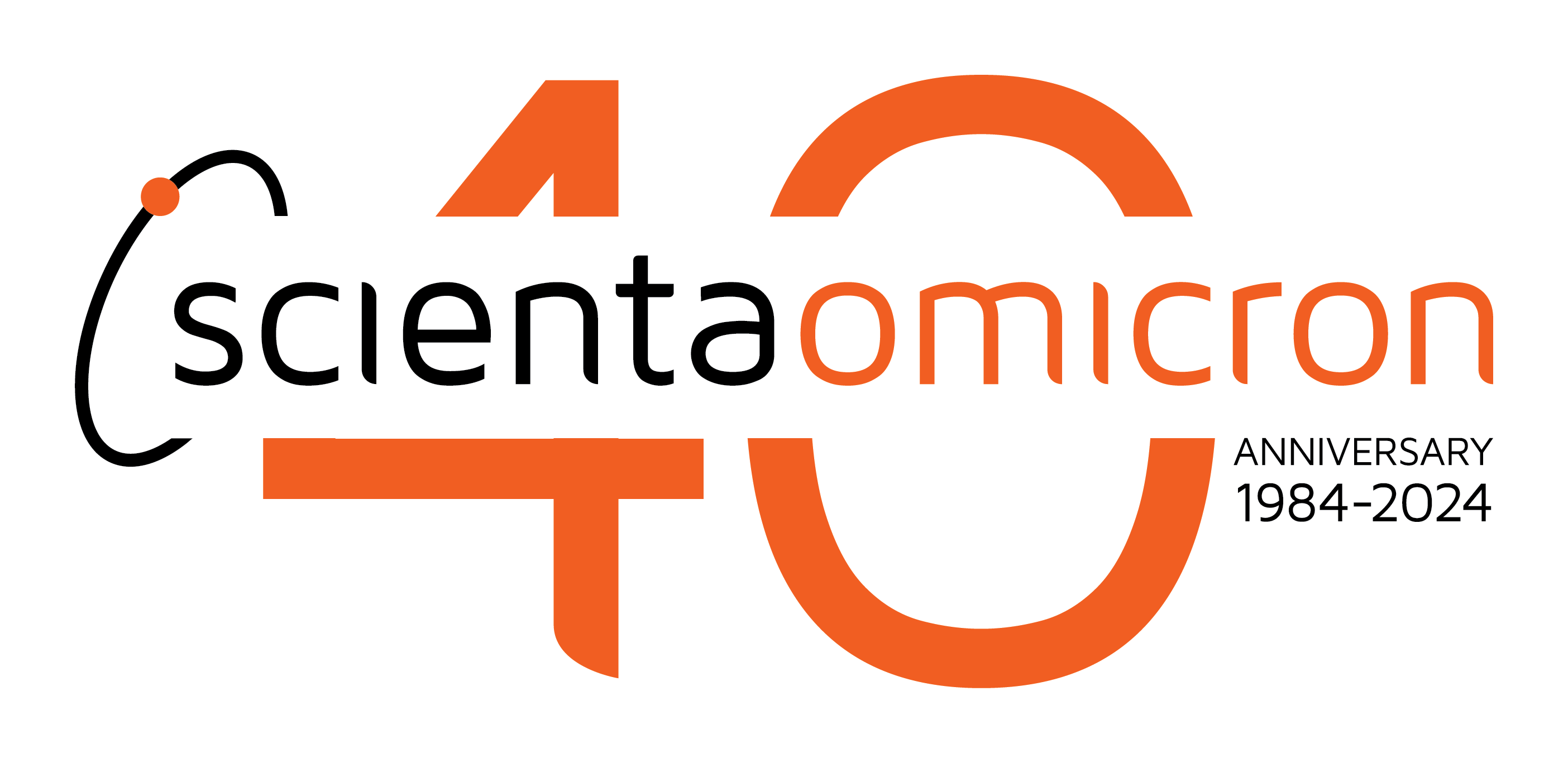Brochures
Electron Spectroscopy Brochures
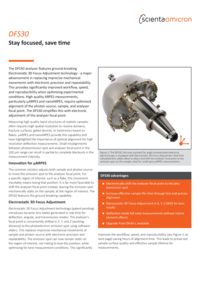
DFS30: Stay Focused, Save Time
The DFS30 analyser features ground-breaking Electrostatic 3D Focus Adjustment technology - a major advancement in replacing imprecise mechanical movements with electronic precision and repeatability. This provides significantly improved workflow, speed, and reproducibility when optimizing experimental conditions. High quality ARPES measurements, particularly μARPES and nanoARPES, require optimised alignment of the photon source, sample, and analyser focal point. The DFS30 simplifies this with electronic adjustment of the analyser focal point.
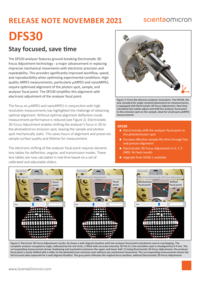
DSF30: Release Note
The DFS30 analyser features ground-breaking Electrostatic 3D Focus Adjustment technology - a major advancement in replacing imprecise mechanical movements with electronic precision and repeatability. This provides significantly improved workflow, speed, and reproducibility when optimising experimental conditions. High quality ARPES measurements, particularly μARPES and nanoARPES, require optimised alignment of the photon spot, sample, and analyser focal point. The DFS30 simplifies this alignment with electronic adjustment of the analyser focal point.
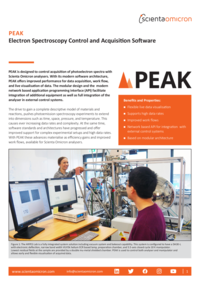
PEAK: Electron Spectroscopy Control and Acquisition Software
PEAK is designed to control acquisition of photoelectron spectra with Scienta Omicron analysers. With its modern software architecture, PEAK offers improved performance for data acquisition, work flow, and live visualisation of data. The modular design and the modern network based application programming interface (API) facilitate integration of additional equipment as well as full integration of the analyser in external control systems.
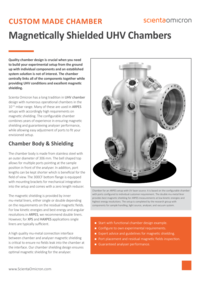
Custom Made Chamber: Magnetically Shielded UHV Chambers
Quality chamber design is crucial when you need to build your experimental setup from the ground up with individual components and an established system solution is not of interest. The chamber centrally links all of the components together while providing UHV conditions and excellent magnetic shielding.
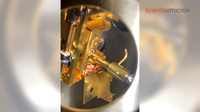
ARPES Cryo Manipulator Operations (Video)
A complete range of cryo manipulators is available for the ARPES Lab. These state-of-the-art cryo manipulators come in 4-, 5- and 6-axes and both open and closed cycle versions, with lowest possible sample temperatures, proven ARPES performance and attractive pricing.
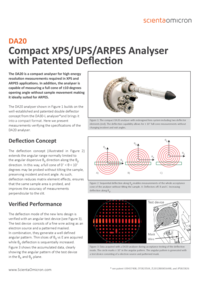
DA20 Compact XPS/UPS/ARPES Analyser with Patented Deflection
The DA20 is a compact analyser for high energy resolution measurements required in XPS and ARPES applications. In addition, the analyser is capable of measuring a full cone of ±10 degrees opening angle without sample movement making it ideally suited for ARPES.
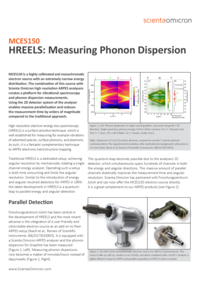
HREELS: Measuring Phonon Dispersion
MCES150 is a highly collimated and monochromatic electron source with an extremely narrow energy distribution. The combination of this source with Scienta Omicron high resolution ARPES analysers creates a platform for vibrational spectroscopy and phonon dispersion measurements. Using the 2D detector system of the analyser enables massive parallelisation and reduces the measurement time by orders of magnitude compared to the traditional approach.
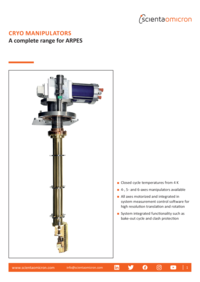
Cryo Manipulators: A Complete Range for ARPES
A complete range of cryo manipulators is available for the ARPES Lab. These state-of-the-art cryo manipulators come in 4-, 5- and 6-axes and both open and closed cycle versions, with lowest possible sample temperatures, proven ARPES performance and attractive pricing.
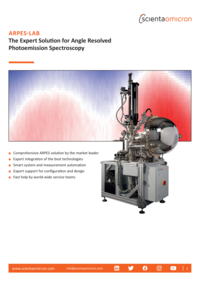
ARPES Lab: The Expert Solution for Angle Resolved Photoemission Spectroscopy
Angular resolved photoemission spectroscopy (ARPES) has emerged as the most powerful technique to understand the electronic structure of materials and what can influence their physics and chemistry.
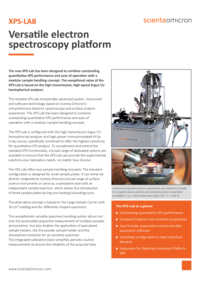
XPS Lab: Versatile Electron Spectroscopy Platform
The XPS Lab has been designed to combine outstanding quantitative XPS performance and ease of operation with a modular sample handling concept. The exceptional value of the XPS Lab is based on the high-transmission and high-speed Argus CU hemispherical analyser.
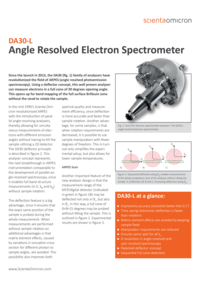
DA30-L: Angle Resolved Electron Spectrometer
Since the launch in 2013, the DA30 family of analysers have revolutionised the field of ARPES. Using a fast electrostatic deflector concept, this well proven analyser can measure electrons in a full cone of 30 degrees opening angle. This opens up for band mapping of the full surface Brillouin zone without the need to rotate the sample and preserves incident and exit angles. The deflection capability ensures fixed spot shape and position on the sample and eliminates mechanical backlash, information depth variations, and angle dependent matrix element effects.
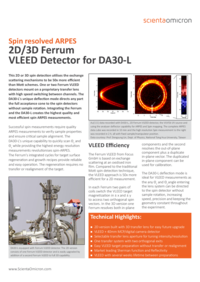
2D/3D Ferrum VLEED Detector for DA30-L
This 2D or 3D spin detection utilizes the exchange scattering mechanisms to be 50x more efficient than Mott schemes. One or two Ferrum VLEED detectors mount on a proprietary transfer lens with high speed switching between channels. The DA30-L's unique deflection mode directs any part of the full acceptance cone to the spin detectors without sample rotation. Integrating the Ferrum and the DA30-L creates the highest quality and most efficient spin ARPES measurements.
Retractable VUV5k-Package
The retractable VUV5k-package is the combination of the VUV5000 UV-source and the VUV5047 UV-monochromator. These components form a unique light source. The package allows a working pressure in the 10-11 mbar range during lamp operation.
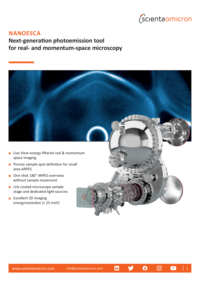
NanoESCA: Next-Generation Photoemission Tool
The Scienta Omicron NanoESCA is a cutting edge instrument with a “Live View” energy-filtered real- & momentum space imaging, offering precise sample spot definition for small area ARPES. The other key features include 1) one-shot 180 degree ARPES overview without sample movement; 2) LHe cooled microscope sample stage and dedicated light-sources; and 3) Excellent 2D imaging energy-resolution.
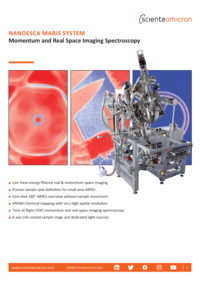
NanoESCA MARIS: Momentum and Real Space Imaging Spectroscopy
Photoemission has established itself as one of the leading techniques in material and surface science. In the last decade, 2D k-space imaging or “Momentum Microscopy” has become one of the latest and most promising developments in this field. It allows insight into the electronic band-structure of novel material systems, unveiling useful effects that can have a strong impact in future information technology. In combination with its real-space imaging capability, NanoESCA MARIS is the ideal tool for investigating the physical properties of materials at the nanoscale, thus enabling the development of next-generation nanodevices.
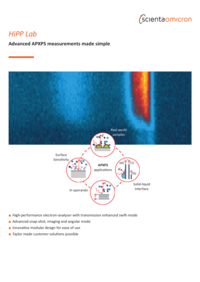
HiPP Lab: Advanced APXPS Measurements Made Simple
With HiPP Lab Scienta Omicron provides a novel solution for laboratory based ambient pressure photoelectron spectroscopy (APPES). Drawing on extensive experience in the fields of photoelectron spectroscopy (PES), UHV technology, and system design, Scienta Omicron has designed the HiPP Lab as an easy to use system that encourages user creativity through flexibility, modularity and an innovate chamber design. Scienta Omicron has vast experience in system manufacturing in a broad range of surface science and material science applications with more than 500 PES analysers and approximately 1000 systems deployed worldwide. This broad knowledge base has been critical for the development of the HiPP Lab.
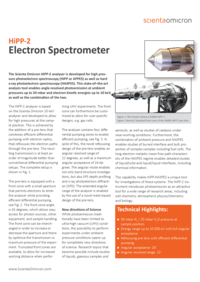
HiPP-2: High Energy Ambient Pressure Electron Analyser
The Scienta Omicron HiPP-2 analyser is developed for ambient pressure photoelectron spectroscopy (HiPP or APPES) as well as hard x-ray photoelectron spectroscopy (HAXPES). This state-of–the-art analysis tool enables angle-resolved photoemission at ambient pressures up to 50 mbar and electron kinetic energies up to 10 keV, as well as the combination of the two.
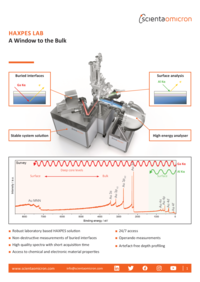
HAXPES Lab: A Window to the Bulk
Scienta Omicron‘s HAXPES Lab brings hard X-ray photoelectron spectroscopy (HAXPES) capability directly to the local laboratory environment. This novel system probes bulk sample properties and accesses deep core level electrons via photoelectron spectroscopy (XPS) without the need for a synchrotron end station. Using world class technology and expert engineering, the HAXPES Lab sets the standard for laboratory based high energy photoelectron spectroscopy.
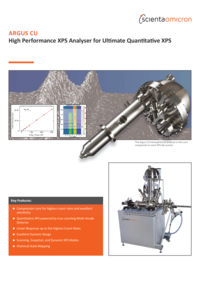
ARGUS CU: High Transmission XPS Analyser
Argus is a high-transmission, high-speed hemispherical analyser with multi-channel detection technology developed and optimised for uncompromised photoelectron spectroscopy. Argus represents a unique approach to multi-channel XPS detection, matching today´s demanding requirements for fast and trusted quantitative XPS, ease-of-use and reliability.
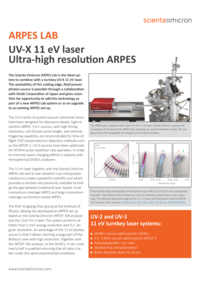
ARPES Lab: UV-X 11 eV Laser
The Scienta Omicron ARPES Lab is the ideal system to combine with a turnkey UV-X 11 eV laser. The availability of this cutting edge, field proven photon source is possible through a collaboration with Oxide Corporation of Japan and gives scientists the opportunity to add this technology as part of a new ARPES Lab system or as an upgrade to an existing ARPES set-up.
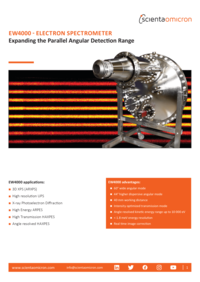
EW4000: Electron Spectrometer
The Scienta Omicron EW4000 opens new directions of science. Where previous Scienta Omicron spectrometers have been a revolution to ARPES, the EW4000 goes one step further. Expanding the parallel angular detection range to 60° gives great possibilities for high transmission measurements as well as novel Standing Wave and XPD experiments.
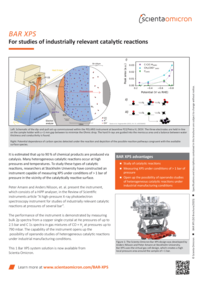
BAR XPS: For Studies of Industrially Relevant Catalytic Reactions
Discover the new high-pressure XPS system from Scienta Omicron, developed at Stockholm University. Designed for operando studies of industrially relevant catalytic reactions, it enables XPS measurements at pressures above 1 bar, providing unique insights into chemical processes as they happen.
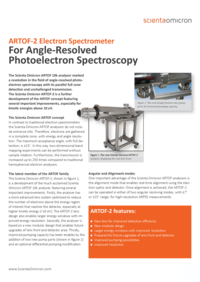
ARTOF-2 Electron Spectrometer: For ARPES
The Scienta Omicron ARTOF 10k analyser marked a revolution in the field of angle-resolved photoelectron spectroscopy (ARPES). Using time of flight (TOF) for energy dispersion and a precisely controlled electron lens system eliminates the need for an entrance slit as used in hemispherical analysers. This results in unrivalled high transmission, parallel full cone detection, and excellent energy resolution for typical ARPES energy ranges. The Scienta Omicron ARTOF-2 further improves the ARTOF concept on energy window width, resolution, and especially for kinetic energies above 10 eV. The high transmission of ARTOF-2 make it ideal for time resolved and coincidence experiments as well as radiation sensitive samples.
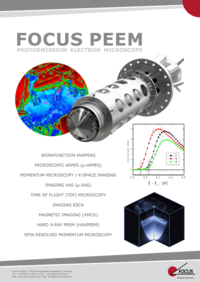
FOCUS PEEM: Photo Emission Electron Microscope
The FOCUS PEEM utilises the technique of photoemission electron microscopy to image electrons emitted from any flat and conducting sample surface. Today the FOCUS PEEM is designed to combine both real- and k-space imaging together with energy filtering and hence spectroscopic microscopy (“spectromicroscopy”) at its best
Scanning Probe Microscopy Brochures
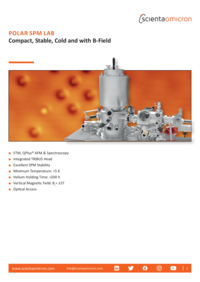
POLAR SPM Lab: Compact, Stable, Cold and with B-Field
The new POLAR UHV SPM is a low-temperature Scanning Probe Microscope (SPM) for highest resolution STM, QPlus® AFM, and spectroscopy experiments in a temperature range of between <5 K and 420 K and in high magnetic fields of up to 5T.
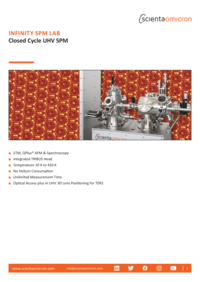
INFINITY SPM Lab: Closed Cycle UHV SPM
The new INFINITY UHV SPM is a low-temperature SPM for high-resolution STM, QPlus® AFM, and spectroscopy experiments. A pulse tube cooler is employed to cool the UHV SPM in a new, unique design. The new cryostat has no moving parts in the cold head and very long service intervals. It belongs to the next generation of cryostats that are independent of cryogenic liquids. The handling of liquid helium or liquid nitrogen is no longer necessary, thus making the use of the instrument simpler and safer. The INFINITY SPM can stay cold for several months without the need for any maintenance of the cryostat.
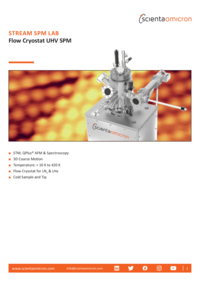
STREAM SPM Lab: Flow Cryostat UHV SPM
The STREAM UHV SPM combines advantages of a cost-effective low-temperature flow cryostat platform with the attractive features of the TRIBUS SPM head including 3D coarse motion, high intrinsic stability, easy tip and sample exchange, and optical access.
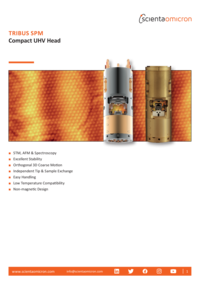
TRIBUS SPM: Compact UHV Head
The ultra-compact TRIBUS is an SPM head for a wide variety of applications. Whether for SPM-spectroscopy, surface imaging, or manipulation of nanoparti cles, for experiments at elevated temperatures, or at the millikelvin scale, in high magnetic fields or in spatially tight environments, the TRIBUS head is the ideal solution when highest resolution, accuracy and flexibility are required.
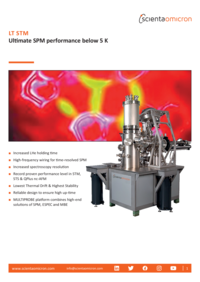
LT STM III: Ultimate SPM Performance Below 5 K
Since its introduction in 1996, Scienta Omicron´s Low Temperature STM has set the standard for stability, performance and productivity for 4LHe bath cryostat STMs. It is a high quality allrounder SPM delivering broad scientific output and regularly groundbreaking results employing usually more than one technique. Its base is an ultra-stable platform offering a large range of operation modes including STM, QPlus AFM, STS, IETS, force spectroscopy, optical experiments and atom manipulation. Scienta Omicron´s LT STM Qplus AFM imaging of “on-surface chemistry”, atom manipulation, carbon, superconductors, semiconductors, gases on metals, and magnetics are only a few examples where research takes great advantage of low temperature SPM.
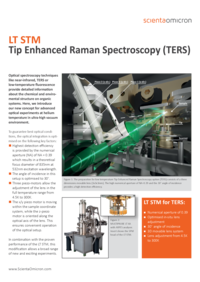
LT STM TERS
TERS - our new concept for advanced optical experiments at helium temperature in ultra-high vacuum environment.

MATRIX 4: The SPM Controller Evolution
The MATRIX 4 Control System builds on 30 years of experience in SPM technology and unlocks the full capacity of our leading-edge Scanning Probe Microscopes. The key features include intuitive and flexible experiment control; best-in-class noise floor; full 64-bit software; and modular upgrade paths.
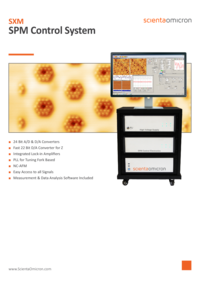
SXM: SPM Control System
The new digital SXM Control System incorporates advances in state-of-the-art electronics and latest software algorithms to fulfill the needs of today’s and future challenges in scanning probe microscopy (SPM). The key features include: 1) 24 Bit A/D & D/A converters; 2) fast 22 Bit D/A converter for Z; 3) Integrated lock-in amplifiers; 4) PLL for tuning fork based; 5) NC-AFM; and 6) easy access to all signals
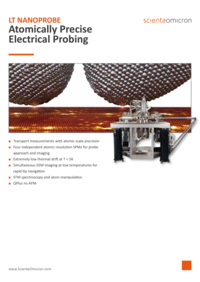
LT NANOPROBE: Atomically Precise Electrical Probing
The Low Temperature Nanoprobe defines a new class of analytical instrumentation that merges SEM-navigated local transport measurements with atomic scale precision, high performance STM imaging, spectroscopy, and manipulation at LHe temperatures. The key features include 1) transport measurements with atomic scale precision; 2) independent atomic resolution SPMs for probe approach and imaging; 3) extreme low thermal drift at T < 5 K; 3) simultaneous SEM imaging at low temperature for rapid tip navigation; 4) STM spectroscopy and atom manipulation; and 5) QPlus® nc-AFM.
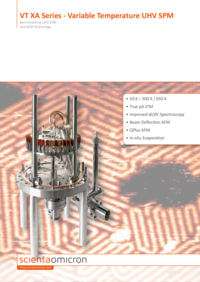
VT XA Series: Variable Temperature UHV SPM
The VT XA design forms a new series of VT instruments using standard Scienta Omicron samples plates. The philosophy of the XA series is to provide maximum compatibility with many different surface science techniques, like MBE, RHEED and different kinds of electron spectroscopy.
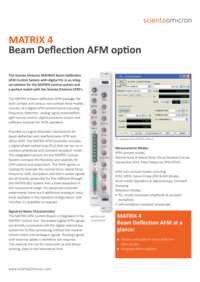
MATRIX 4: Beam Deflection AFM Option
The Scienta Omicron MATRIX 4 Beam Deflection and Plus AFM Control System with digital PLL is an integral solution for the MATRIX control system and a perfect match with the Scienta Omicron SPMs. Includes sensor alignment & control, light source control, resonance/phase curve acquisition, amplitude channel, automatic phase adjustment and more. Processor board with an integrated Kelvin regulator.
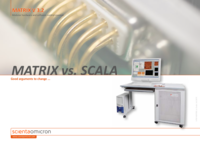
MATRIX vs. SCALA: MATRIX V 3.2
The advantages of the MATRIX Control System over its predecessor SCALA are: easier to use due to a self-explanatory graphical user interface (GUI); improved signal to noise level; a digital scan generator with no electronic drift; a digital regulator with more functionalities and flexibility; more measurement channels; improved AFM control with a new digital PLL controller; automated drift correction by image correlation technique; extended scripting and remote access functions; and flexible for PC model changes.
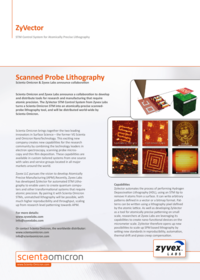
ZyVector: STM Control System for Lithography
Scienta Omicron and Zyvex Labs announce a collaboration to develop and distribute tools for research and manufacturing that require atomic precision. The ZyVector STM Control System from Zyvex Labs turns a Scienta Omicron STM into an atomically-precise scanned probe lithography tool, and will be distributed world-wide by Scienta Omicron.
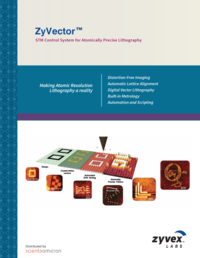
Zyvector Booklet
Zyvex Labs pursues research and develops tools for creating quantum computers and other transformational systems that require atomic precision, towards its eventual goal of Atomically Precise Manufacturing. As part of this effort, ZyVector turns the world-class Scienta Omicron VT-STM into an STM lithography tool, creating the only complete commercial solution for atomic precision lithography.
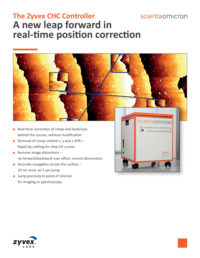
Zyvex CHC Controller
Scienta Omicron and Zyvex Labs announce a new leap forward in STM design; real- time position correction. The ZyVector STM control system from Zyvex Labs uses live position correction to enable atomic-precision STM lithography. Now the same live position correction technology is brought to the Matrix STM control system for microscopy and spectroscopy users, enabling fast settling times after large movements in x, y and z, and precise motion across the surface, landing and remaining at the desired location.
Thin Film Deposition Brochures
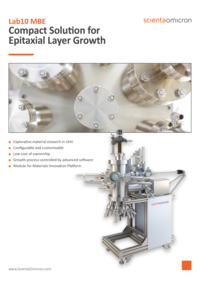
Lab10 MBE: Compact Solution for Epitaxial Layer Growth
The Lab10 MBE is a turnkey small sample research tool for innovative material development under UHV conditions. This system is designed to fulfill the highest and most stringent requirements of modern thin-film deposition. Furthermore, the small sample concept is intended to interface the MBE system with an UHV analysis module to offer the best platform for fundamental research of novel materials.
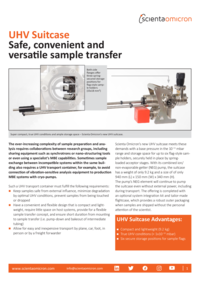
UHV Suitcase: Safe, Convenient and Versatile Sample Transfer
The ever-increasing complexity of sample preparation and analysis requires collaborations between research groups, including sharing equipment such as synchrotrons or nano-structuring tools or even using a specialist‘s MBE capabilities. Sometimes sample exchange between incompatible systems within the same building also requires a UHV transport container, for example, to avoid connection of vibration-sensitive analysis equipment to production MBE systems with cryo-pumps.
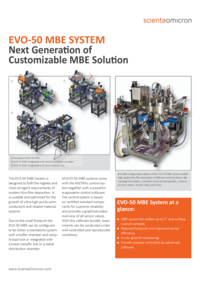
EVO-50 MBE System: Next Generation of Customisable MBE Solution
The EVO-50 MBE System is designed to fulfil the highest and most stringent requirements of modern thin-film deposition. It is suitable and optimised for the growth of ultra-high purity semiconductors and related material systems.
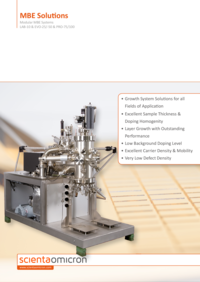
MBE Solutions: Modular MBE Systems
The MBE Solution is comprised of Lab10 MBE, EVO-25/-50 and PRO-75/100 enabling MBE and analysis in a single system. The key features include 1) excellent sample thickness and doping homogeneity; 2) layer growth with outstanding performance; 3) low background doping level; 4) excellent carrier density and mobility; and 5) very low defect density.
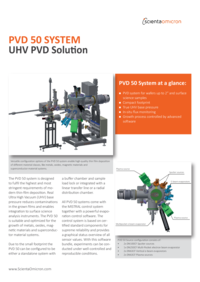
PVD 50 System Brochure
The PVD 50 system is designed to fulfill the highest and most stringent requirements of modern thin-film deposition. Real Ultra High Vacuum (UHV) base pressure reduces contamination in the grown films and enables integration to surface science analysis instruments. The PVD 50 is suitable and optimised for the growth of metals, oxides, magnetic materials and superconductor material systems.
